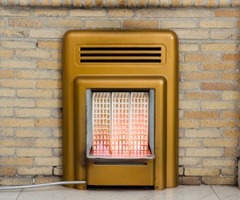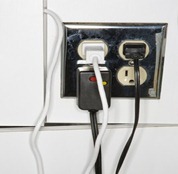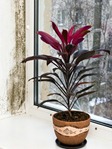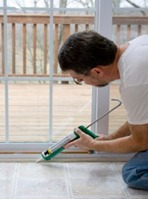Keeping Warm, Keeping Cool: Keeping the Goldilocks Rule
 Insulation, sealing and ventilation can sound like boring subjects, but they’re not boring if you’re living in a house that doesn’t have them. Anybody who could tell Mary Ebbets how to solve the problems with her new house would have certainly had her and her husband’s attention, especially when their new house was being built. They may have been happy that they were no longer paying extra to heat their old house, but they didn’t they like living with the discomfort and the bad health effects of their new one.
Insulation, sealing and ventilation can sound like boring subjects, but they’re not boring if you’re living in a house that doesn’t have them. Anybody who could tell Mary Ebbets how to solve the problems with her new house would have certainly had her and her husband’s attention, especially when their new house was being built. They may have been happy that they were no longer paying extra to heat their old house, but they didn’t they like living with the discomfort and the bad health effects of their new one.
They didn’t realize that a well-insulated and sealed house that’s not well ventilated is a health hazard: during a humid summer, walls and furniture can get moldy; the rest of the time, toxic compounds off-gassing from furniture and finishes accumulate and make the people who live in the house ill.
 Their old house was “ventilated” by leaks around ill-fitting doors and windows and probably had patches in the walls where the insulation was missing – if it had any at all. When it wasn’t just plain uncomfortable, their furnace worked overtime most of the winter. In good years, they considered themselves lucky to be able to keep the heat up; in bad years, they spent a lot of time being cold.
Their old house was “ventilated” by leaks around ill-fitting doors and windows and probably had patches in the walls where the insulation was missing – if it had any at all. When it wasn’t just plain uncomfortable, their furnace worked overtime most of the winter. In good years, they considered themselves lucky to be able to keep the heat up; in bad years, they spent a lot of time being cold.
Between the old house and their new one, the got the worst of each kind of house. What they needed was thermal comfort.
What’s Thermal Comfort?
What’s your thermal comfort zone? The fact is, “too cold” or “too hot” is basically an opinion. That’s why, in 1966, ASHRAE, the American Society of Heating, Refrigeration and Air-conditioning Engineers created a building standard for “Thermal comfort.” This standard, (updated as of 2004), sets an acceptable range for humidity; for indoor temperature limits for winter and for summer; and for the speed that ventilating air should move through a space. It actually starts out by saying that “Thermal comfort is that condition of mind that expresses comfort with the condition of the thermal environment.” Insulation, sealing and ventilation have to work together to provide you with thermal comfort, but you’ll want to consider them separately before you understand them together.
Insulation Slows Heat
It’s the insulating properties of the outer walls, floors and ceilings of a space that decide how quickly the space is going to equal the  temperature of the air outside. A good conductor, like tin, transfers the temperature of the outside air to the inside in a hurry, while an insulator slows the process. If a wall is well insulated, it takes longer to conduct the heat or cold inside. Under a desert sun, a thick wall of adobe bricks and mortar can slow the transfer of heat to the inside long enough so that the cold desert night falls before the heat reaches the inside of the wall and heats up the house. Overnight, the heated wall cools down again and keeps the house cool through the next day.
temperature of the air outside. A good conductor, like tin, transfers the temperature of the outside air to the inside in a hurry, while an insulator slows the process. If a wall is well insulated, it takes longer to conduct the heat or cold inside. Under a desert sun, a thick wall of adobe bricks and mortar can slow the transfer of heat to the inside long enough so that the cold desert night falls before the heat reaches the inside of the wall and heats up the house. Overnight, the heated wall cools down again and keeps the house cool through the next day.
Conventionally built wood houses houses slow down heat transfer by putting insulation material inside the inner and outer walls. Before there was fiberglass and plastic insulation, people stuffed straw, bark and earth into their walls. Traditional thatched roofs several feet thick were good insulators, even though they were shared by birds, squirrels and other rodents.
When insulation is inserted between inner and outer walls, it needs to be very continuous, something that traditional houses understood.  There shouldn’t be any spaces between pieces of insulation or between the edges of walls and the insulation material. There shouldn’t be any opening, like for an outlet or a vent, where the insulation isn’t right up against it. It’s surprising how often you can put your hand in front of an electrical outlet in a house and feel a cold breeze on a winter day.
There shouldn’t be any spaces between pieces of insulation or between the edges of walls and the insulation material. There shouldn’t be any opening, like for an outlet or a vent, where the insulation isn’t right up against it. It’s surprising how often you can put your hand in front of an electrical outlet in a house and feel a cold breeze on a winter day.
Besides continuity, the thickness of the insulation determines whether it will maintain a desired temperature efficiently. How thick your insulation should be depends on what part of the world you live in and where the insulation is going – in the walls, or under the roof or attic. If you have the right thickness and no gaps, your insulation will work perfectly. But you still have to seal.
Sealing is the Secret
 To understand sealing, you need to get back to that moment in high school (or maybe earlier) when you learned that the solid world we live in is made of molecules, and the molecules are made of atoms. If you were small enough, you could fly through walls. In fact you wouldn’t know they were there. The world inside the wall would look much more like the night sky, with the atoms, electrons and molecules like nearer and farther stars.
To understand sealing, you need to get back to that moment in high school (or maybe earlier) when you learned that the solid world we live in is made of molecules, and the molecules are made of atoms. If you were small enough, you could fly through walls. In fact you wouldn’t know they were there. The world inside the wall would look much more like the night sky, with the atoms, electrons and molecules like nearer and farther stars.
That’s why in a one cup – eight ounces – of water can diffuse right through a well-sealed 100-square foot wall made of sheetrock in a year. It does this as billions of molecules of water find their way through the atomic structure of the wall, though it happens too slowly for us to notice. But if there is the equivalent of a half-inch diameter hole somewhere in that wall, everything changes: 50! cups of water can enter through that hole in the same time. That’s why, in climates humid enough to produce 50 cups – over three gallons – of water vapor per 100 sq ft a year, you can end up with a damp wall. And when a wall is damp long enough, you get mold.
 Mold inside walls can make people sick because inhaling mold spores over a period of time can sensitize people. According to the CDC, “for sensitized persons, hay fever symptoms and asthma exacerbations are prominent manifestations of mold allergy.” The spectacular kind of mold that gets your attention appears after flooding, like after Katrina, but mold leaking into a poorly sealed house is very gradual and more insidious. The inhabitants get used to the smell, and don’t realize that some of the physical symptoms they’re experiencing are due to mold spores in the air. It doesn’t make the news, but it can still change your life.
Mold inside walls can make people sick because inhaling mold spores over a period of time can sensitize people. According to the CDC, “for sensitized persons, hay fever symptoms and asthma exacerbations are prominent manifestations of mold allergy.” The spectacular kind of mold that gets your attention appears after flooding, like after Katrina, but mold leaking into a poorly sealed house is very gradual and more insidious. The inhabitants get used to the smell, and don’t realize that some of the physical symptoms they’re experiencing are due to mold spores in the air. It doesn’t make the news, but it can still change your life.
A couple who owned a beautiful house on the bay in Sag Harbor, on Long Island, had to leave it because they could no longer live in it. They finally learned that the reason they were becoming sicker and sicker with respiratory and skin allergies was that their house was permeated with mold. Until they were shown, they had never seen that there was mold behind furniture that had always stood against a wall; there was mold in the backs of their closets; mold had permeated towels and linen that hadn’t been used for a long time. When they moved out, they were horrified to find that even the bottom of their mattresses had traces of mold.
But a house that isn’t properly sealed isn’t only a health hazard; it’s an energy-eater. In winter, the cold outside sucks out the warm air which you’ve paid good money to heat. Depending on the wind, cold air may even blow right in. When the Evans family had an energy audit done on their home in Millerton, New York, the contractor who was doing the audit found that the wall to the left of the large brick fireplace had separated enough – a good quarter inch – so that you could see daylight through the space. The family had noticed that the living room was colder than the rest of the house every winter, but probably because they had almost never sat in front of the fireplace during the daylight hours, they had never noticed this opening.
Although th ere aren’t always outright leaks through the walls, most older American homes leak around windows and around outside doors. Even if a window fits tightly into its frame, there are often breaks in what should be a thermal seal around the window assembly. Infrared pictures of houses often show red spots around windows where heat from the house is escaping.
ere aren’t always outright leaks through the walls, most older American homes leak around windows and around outside doors. Even if a window fits tightly into its frame, there are often breaks in what should be a thermal seal around the window assembly. Infrared pictures of houses often show red spots around windows where heat from the house is escaping.
Sealing is the cheapest and most effective single thing homeowners can do. All it takes is a caulking gun and some caulk.
Ventilation That Isn’t There
Bart and Ellen Lennox’s house is snug like the Ebbets’ new home, but the family has headaches and coughs a lot. Their bathroom has a fan – you can hear it when you put on the light – but the bathroom smells take a long time to dissipate. The bathroom also has a window, but it’s never opened. In fact it was painted shut last time they painted the house. The kitchen has a fan over the stove, but unless something is burning, Ellen usually forgets to turn it on. After all, it doesn’t seem to have much effect when she does – and besides, she says, it’s noisy as anything and she can’t hear what anybody is saying if she’s cooking.
This is an American story that’s repeated often. The bathroom fan probably just needs cleaning – if a bird hasn’t made a nest in the vent. The kitchen hood probably needs replacement – with a quieter one to encourage its use – and the vent to the outside needs to be checked for blockage as well. If these vents were to work well, and be used, the air in the house will definitely improve.
But what a well-sealed modern house really needs is a constant flow of fresh air, enough so that the people who live there experience thermal comfort both in winter and in summer, while their energy bills stay as low as possible. There are a number of ways to achieve this, and no one way is right. The main thing is that the right amount of fresh air is coming in and stale air is going out.
Venting: the Goldilocks Rule
In many areas of the country, the solution is a whole-house fan in the attic. Unfortunately, the air the fan exhausts often comes in through the kind of leaks we’ve been mentioning. Worse, radon and/or furnace combustion gases are often drawn up from the basement – rarely enough to kill the family, but often enough to keep them less than well.
In other houses, the fans that draw air out of the rest of the house are installed in the bathroom and kitchen, where they exhaust directly to the outside. But like the home of the Lennoxes, the fans aren’t working and the air isn’t moving when nobody is in the bathroom or the kitchen0. In the case of the well-sealed house without well-planned incoming air, the people who live in it might not breathe radon and combustion products, but they are probably inhaling the chemicals slowly emitted from their furniture and its finishes. They’re also absorbing chemicals emitted from the products that are used to clean the house, not to mention the CO2 everybody else is breathing out.
But moving air takes motor-driven fans and uses electricity, so it’s important that ventilation is designed for the Goldilocks rule: the amount of air refreshed should be not too much and not too little. It should be just right.
The American standard for home ventilation says that every person needs 15 cubic feet of fresh air every minute – about the space on the inside of a medium-sized refrigerator. So, if there are usually four people in a house, the ventilation system needs to be able to move 60 cubic feet a minute when everybody’s home in the evening, and less when everybody is out during the day.
To get it “just right” requires some knowledgeable calculations, but we can consider a number of strategies.
The simplest involves passive vents in every occupied room. A passive vent, sometimes called a “trickle ventilator,” is designed to allow just enough air to flow into a room to keep the air fresh, but not enough to create any sense of air movement. It can be built into a window frame or inserted into an outer wall. A whole-house fan gently removes air from the house, creating a negative pressure that pulls fresh air into each room through the passive vents. The fan can be on a timer and work at different speeds to reflect the needs of the household at a given time.
The intake into each occupied room can also be an opening from a dual duct system connected to a pair of fans, one for intake and one for exhaust that provide balanced ventilation. The exhaust system takes air from the bathrooms and kitchen. The intake fan and ducts provide air to all other rooms.
The most sophisticated system combines balanced ventilation with an energy-recovery ventilator. If there’s a difference in temperature between the incoming air and the temperature inside the house, the incoming air is heated or cooled to the temperature you choose. With a heat-recovery ventilator, for example, cold winter air is heated as it’s pulled in to match the temperature of the air that’s being exhausted. If your house is in the Arizona desert, your energy-recovery ventilator will cool the incoming air.
That’s how you get thermal comfort, stay healthy and enjoy your home.




This is an excellent and very readable article. I would only quibble with one small point: It’s not just the mold spores that cause irritation and illness, but also the mVOCs molds emit, which gives mold its odor. These are gaseous chemicals such as acetones, alcohols, benzenes, methyl chloride, and so on. They often compound problems caused by the outgassing of synthetic products you mentioned.